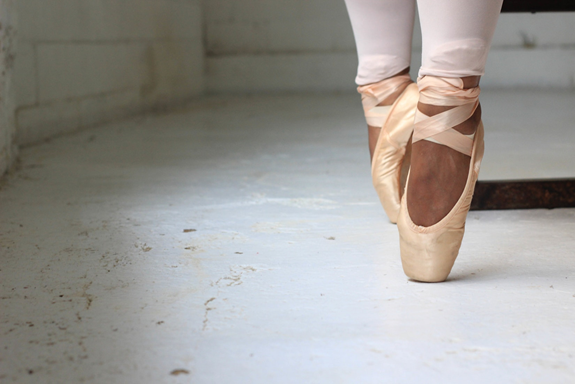
Sara Desroches
May 6, 2018, 9:05 p.m.

The link between the ballet world and eating disorders is fairly well known— articles about problematic and harmful practices are in abundance. Several clients have told me how ballet directly contributed the onset of their ED (be it due to body image issues, themes of perfectionism, weight/shape bias in the professional sphere, and so on). Suffice to say, for some folks living with an eating disorder, ballet has painful and/or harmful association. This got me thinking: what can we, as folks in the “eating disorder world”, do to facilitate re-claiming ballet?
Dance Movement Therapy (DMT) is a therapy utilized by clinicians for a variety of reasons; and although it is not a widely available treatment, DMT has been shown to be effective for clients with eating disorders. One “side effect” of having an eating disorder for some folks is emotional and physical numbing— the eating disorder wants you to ignore what your body is saying, and what your soul is feeling. The ED encourages this disconnect. DMT provides “a method for reconnecting the mind and the body through movement” (Palmer, 2015).
So what does an eating disorder-informed ballet class look like? It looks like focusing on the movement in it of itself as a worthwhile and pleasurable activity. It looks like focusing on which muscles allow you to do a plié, and encouraging self-directed gratitude that your body allows you to do that movement. It looks like listening to your body during cool-down stretches; does this stretch feel comfy and rehabilitative, or does it feel like pain—burning, tearing, searing? It looks like asking the perfectionism voice to take a backseat, even if just for an hour on this specific day, so that we can lean how to do a waltz step with minimized self-judgment. It looks like wearing comfy clothing that you can move your body in, and focusing on the functionality of the outfit verses how it looks on the body.
Asking clients with eating disorders to come to a class where the activity is so strongly associated with stigma and weight and shape preoccupation may seem counter-intuitive. However, there is power in re-claiming something. This is not to say that ballet is for everyone or that everyone needs to re-claim it; it just means that an opportunity ought to exist for folks to re-claim things that professionals may consider “scary” or “taboo” (such as ballet). Just because something has been traditionally problematic, doesn’t mean that it always has to be. Ballet, in my humble opinion, can just be about enjoying the movement and appreciating one’s body for allowing you to express movement and creativity. It can be about stepping outside of one’s comfort zone in a safe way, where executing dance moves perfectly is not the end goal. Doing ballet through a Dance Movement Therapy lens offers clients an opportunity to “renew the bond between body and emotions, as well as to work with body image acceptance” (Vende et al., 2016).
My intention is not to diminish the impact that past experiences with dance have had on some folks living with eating disorders. The memories, both emotional and physical, can be nothing short of traumatic. I am sorry that ballet has done this to you. I understand that re-engagement can be scary. I have danced for over fifteen years, including experience doing competitive dance and teaching. Of all the styles that I tried, ballet has brought me both joy and sorrow. I felt joyful doing the moves, expressing creativity and feeling elegant with my body— but sorrow, pressure, and immense guilt when I couldn’t do the moves “perfectly” or couldn’t live up to the standards set by either myself, or others. I remember the day that one of my favorite teachers told me I would never execute a fouette properly because of one unchangeable aspect of my body. But I refuse to believe that that is the only narrative.
Ballet, we’re coming for you. And we’re bringing body positive, health-at-every-size, recovery-focused power with us.
BIO: Sara Desroches has a Master’s of Social Work from the University of Toronto, and has had the privilege of working with clients living with eating disorders in Toronto, Ontario. In her spare time, she loves cuddling with her cat, doing piquay turns across her living room floor, and fighting the patriarchy. Sara hopes to continue working with folks living with eating disorders, especially if it incorporates her love of, and belief in the rehabilitative powers of, drama and dance.
References & Further Reading
Krantz, M.A. (1999) Growing into her body: Dance movement therapy for women with eating disorders. American Journal of Dance Therapy, 21, 2, 81-103.
Krueger, D. W., & Schofield, E. (1986). Dance/movement therapy of eating disordered patients: A model. The Arts in Psychotherapy, 13(4), 323-331.
Levy, F. J. (1992). Dance movement therapy: A healing art. Washington, D.C.: ERIC Clearinghouse.
Meekums, B., Vaverniece, I., Majore-Dusele, I., & Rasnacs, O. (2012). Dance movement therapy for obese women with emotional eating: A controlled pilot study. The Arts in Psychotherapy, 39(2), 126-133.
Palmer, A. (2015). The lived experience of Dance/Movement therapists working with patients with eating disorders. American Journal of Dance Therapy, 37(2), 113-134.
Vende, K., Orinska, S., Majore-Dusele, I., & Upmale, A. (2016). Dance and movement therapy for patients with ED. In Creative arts therapies and clients with eating disorders (pp. 241-262). London: Jessica Kingsley.
Resources for dance teachers/Coaches:
http://itsjennaj.com/index.php/2018/02/19/avoid-triggering-bad-body-imag...
https://dalspace.library.dal.ca/bitstream/handle/10222/73109/Doria-Nicol...
(There is a chapter specifically about coaches/teachers starting on page 63)
http://www.dance-teacher.com/dancers-and-eating-disorders-2539914379.html